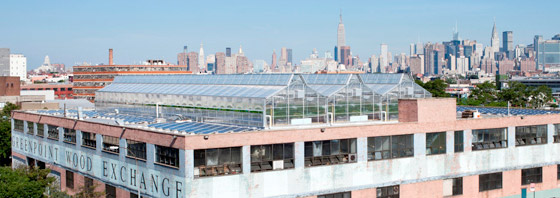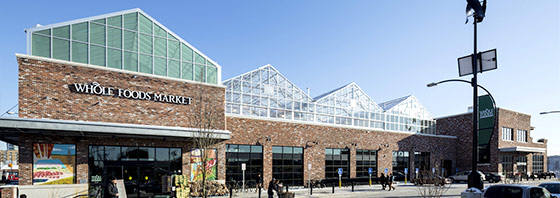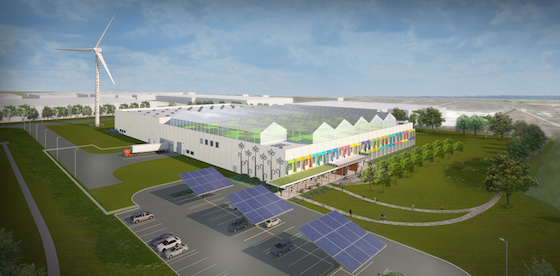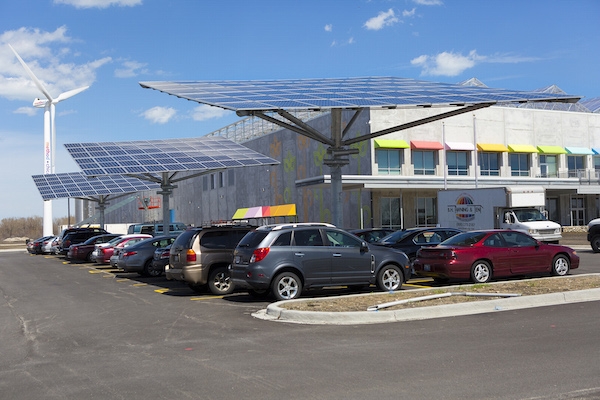First they took New York. Now Gotham Greens is set to expand in Chicago with what it’s calling the world’s largest rooftop farm. From the company’s new 75,000 square foot hydroponic greenhouse perched above a new soap factory, Gotham Greens plans to grow a million pounds of pesticide-free tomatoes, herbs and leafy greens each year.

Gotham Green’s Hydroponic Lettuce
The privately owned company already has two working hydroponic greenhouses in Brooklyn, including one on top of a Whole Foods Market, and is about to open another one in Jamaica, Queens that will be almost as big as the one in Chicago. The New York sites will supply more than a hundred stores and restaurants, while the Chicago-raised greens, growing atop a factory for Method cleaning products, will line the produce shelves of local stores, including possibly a nearby Walmart store.
The expansion for the New York-based company comes as experts say urban farming will continue to grow as more people continue to move to cities in coming years. Hydroponic farming, especially when paired with solar and wind to power the greenhouse’s operations, is also likely to grow, experts say.
History of Gotham Greens
Founded in New York 2008, Gotham Greens Farms opened a 15,000 square foot greenhouse on the roof of a two-story building in the Greenpoint neighborhood of Brooklyn in April 2011. Before long it was producing more than 100 tons of greens and tomatoes each year.

Rootfop Greenhouse in Greenpoint, Brooklyn
Among its early clients were Whole Foods stores across New York, and the company tapped Gotham Greens to build a greenhouse on top of its new Gowanus, Brooklyn store in 2013. The Queens, New York greenhouse is set to open later this year, as is the new facility in Chicago. The farms produce a range of leafy greens and herbs — butterhead lettuce, basil, red oak leaf lettuce, bok choy, arugula, swiss chard, baby kale — as well as tomatoes. The company focuses on leafy greens because they don’t store or ship as well as other vegetables, which means locally grown greens are likely to be in better shape — and command a higher price.
The company designs, builds, finances and operates its own greenhouses, distributing the bounty through area supermarkets and restaurants. Its client roster now numbers more than 100 retail outlets across New York City, Long Island and New Jersey, as well as more than a dozen restaurants. Besides Whole Foods, customers include D’Agostino’s, Fresh Direct, Union Market, Mario Batali’s Eataly and Gramercy Tavern.

The urban greenhouse at Whole Foods in Gowanus, Brooklyn
The company was cofounded by CEO Viraj Puri and CFO Eric Haley; its Chief Agriculture Officer is Jennifer Nelkin Frymark. Puri had previously developed and run start-ups in New York, India and Malawi, with a focus on renewable energy, green building and environmental design. Haley specialized in M&A, capital raising and strategic consulting in the investment banking and private equity spaces. Frymark, who joined the company in 2009, is experienced in greenhouse system design, plant nutrition, and crop and pest management, and has the distinction of having managed greenhouses at the South Pole as well as working at a greenhouse at a luxury resort on the Caribbean island of Anguilla.
What is hydroponic farming?
Hydroponic farming means growing vegetables and other plants in a solution, typically nutrient-enhanced water, rather than soil. The resulting produce looks and tastes the same as soil-grown plants, proponents say, and the process cuts down on the threat of pests and disease. There are no weeds to take care of, and when a greenhouse is used, it’s much easier to control pests without pesticides or other chemicals. The controlled greenhouse environment also reduces the risk of contamination by pathogens like E. coli and salmonella, Gotham Greens says.
Hydroponic plants can grow up to twice as fast as soil-based plants, since they don’t have to spend energy on growing an extensive root system. They also take up less space, which means a farmer can produce more crops in the same amount of space, and the greenhouse environment means they can produce vegetables all year long.
There are concerns, backed up by some studies, that hydroponically-grown plants have lower amounts of carotenoids — plant compounds like beta-carotene and lutein that are good for human health — than do traditionally-raised plants. Hydroponically grown plants aren’t considered “organic,” and in fact some organic farmers and consumers don’t like hydroponics because they think the healthiest, and tastiest, vegetables require micro-nutrients, minerals and organic material in the soil — none of which hydroponic plants get.
Still, hydroponic farming — particularly on an urban rooftop — brings other benefits, including a significant reduction in the resources needed to get the produce from farm to table. Lettuce doesn’t have to be shipped from California, or even from upstate New York; in the case of the greenhouse on top of the Whole Foods in Brooklyn, it literally doesn’t have to be shipped at all.
Urban farming makes for a more efficient use of urban land overall, says Roger Schickedantz, director and architect at William McDonough + Partners, which designed the Method factory in Chicago. In fact, one “key benefit” to urban farming, Schickedantz says, is in the reuse and revitalization of older buildings.
Old industrial cities are prime targets for rooftop greenhouses. “It makes the most sense to put an urban rooftop farm where there are old concrete buildings that are solid, with heavy structures that can support the weight,” Schickedantz says.
And a rooftop greenhouse, whether hydroponic or not, can provide a revenue stream to business owners who can monetize the real estate that previously had laid fallow, while also providing insulation for the building below.
Hydroponic farming typically uses less water than conventional farming, but urban greenhouses use more energy to power their lighting, pumps, and heating and cooling systems. Greenhouse operators like Gotham Greens offset that with have solar cells, and sometimes wind generators, as well as extra glazing on the glass, natural ventilation and high-efficiency fans and pumps. The urban heat island effect also reduces heating needs in the winter. Gotham Greens greenhouses include multiple sensors to track temperature, humidity, lighting, and levels of oxygen and carbon dioxide. The greenhouse roof opens and closes automatically as needed to moderate temperatures; also automated are heat lamps, misters, and shades for when it gets too hot.
In the end, while hydroponic greenhouse farming is more expensive, it’s also more efficient. With year-round growing, it can produce 20 times as much produce, with 10 times less water, than traditional growing, Puri has said. And Gotham Greens and other urban hydroponic growers say that, through technology and proper planning, they can produce vegetables with a lower total energy input than traditional greenhouses or field farming — and with much lower carbon emissions.
Urban agriculture — whether in hydroponic rooftop greenhouses or plots in vacant land scattered across aging cities — is expected to continue to grow across the U.S. Governments are encouraging the move with various incentives and programs; California, for example, allows tax breaks for landowners who lease space to urban farmers, according to sustainable agriculture consultant Seedstock, while other governments are actively encouraging the building of rooftop greenhouses. Research firm IBIS World estimates that revenue from hydroponic greenhouses in the US will total $554.5 million this year, a 2.1% increase over 2014.
Gotham Greens facilities in Chicago and Gotham
Gotham Greens is making its first foray out of its New York home with its new 75,000 square foot hydroponic greenhouse on the roof of a new factory for Method, the eco-friendly cleaning supplies manufacturer, in the Pullman neighborhood on Chicago’s far south side. The area is named for the Pullman Palace Car company, which built its eponynmous rail cars in the area a century ago; the neighborhood later declined, and the Method factory is part of a resurgence of investment in the area. Gotham Greens will own and operate the greenhouse facility, leasing the rooftop space from Method, and expects to grow about a million pounds of produce each year. The factory opened earlier this year; the greenhouse will start growing soon.

Rendering of Method’s Soap Factory in Chicago
The factory overall has a LEED Platinum rating by the U.S. Green Building Council, says Schickedantz, and will use 68% less energy than a traditional factory. The rooftop greenhouse will produce even more savings, he says, since it provides insulation for the building to prevent heat loss in the winter, while preventing solar rays from hitting the building and heating it up in the summer.
Gotham Greens will distribute produce from the new greenhouse to supermarkets and restaurants, as well as through farmers markets and community groups. Walmart has a “supercenter” located adjacent to the Method factory, about 50 feet away, and Gotham Greens is “in discussions” with the retailer about distributing through that store, a Gotham Greens spokeswoman says.
The greenhouse is just one part of Method’s efforts to make its new factory green and sustainable. It has a 230-foot wind turbine that’s expected to generate half of the factory’s annual electrical needs. It will also get juice from a trio of 35 by 35 foot solar “tracking trees” in the parking lot, which will rotate during the day to follow the path of the sun, resulting in more PV generation.

Solar panels at Method’s Soap Factory in Chicago
Besides the greenhouse the roof includes a 1,520 square foot canopy — plants growing on the roof, not inside the greenhouse — to help cut down on energy use and stormwater runoff, as well as improve air quality.”
Gotham Greens is also continuing to grow in New York with a new 60,000 square foot greenhouse in Jamaica, Queens. Set to open in the fall, it’s being built on top of a four-story industrial building. Funding sources included $900,000 from the New York State Regional Economic Development Council.
Gotham Greens’ business model has always involved distributing its produce through supermarkets; it has been putting its vegetables on the shelves of New York-area Whole Foods Markets since 2011, soon after it began production. And when the high-end supermarket was getting set to build its first-ever store in Brooklyn, it tapped Gotham Greens to run a 20,000 square foot greenhouse on the roof. It was to be the “first commercial-scale greenhouse farm integrated into a supermarket,” Gotham Greens said in a 2013 statement announcing the arrangement.
The facility, owned and operated by Gotham Greens, produces more than 200 tons of leafy greens, herbs and tomatoes a year. It uses the same working technologies as other hydroponic greenhouses, including recirculating irrigation systems that capture water for reuse, enhanced glazing and high-efficiency pumps and motors to reduce energy demand. The project includes a 157 kilowatt Combined Heat and Power (CHP) plant, as well as a 325 kilowatt photovoltaic system in the store’s parking lot.
Building owners have different reasons for leasing their rooftop to a greenhouse operator. For Method, Gotham Greens’ efficient use of water was key. “Water issues are important to [Method cofounder] Adam Lowry, as Method is a big water user,” Schickedantz says.
Whole Foods indicated that they liked the hyper-local aspect of selling food that’s grown literally above shoppers’ heads, as well as the freshness and nutrition of the hydroponically grown plants. The company also liked the water efficiency of the process, and the fact that it would eliminate long-distance food transportation and the carbon emissions that come with trucking.
For progressive-minded companies, of course, there’s also the intangible perception benefit that can come from having sustainable farming on the roof of their building.
Gotham Greens’ funding history
Gotham Greens raised nearly $3 million in Series A funding in 2010 from angel investors. Attracting initial financing was a challenge, Puri said in 2012. But he found that making sure the company had scientists and technical personnel on its roster made the company much more compelling to potential investors and partners.
Other early-stage financing came from the New York State Energy Research and Development Authority (NYSERDA), which gave the company $400,000 under its Energy Productivity in Innovative Local Food Production Systems program. It later secured a $900,000 term loan from the New York Business Development Corporation, and got another $250,000 from NYSERDA in 2014.
In applying for state funds for their first project, Gotham Greens told NYSERDA that its resource efficiencies would keep costs under control, and that it would receive strong revenue from being in the high-value retail market of New York City. The company expected gross profit margins to exceed 35 percent, according to documentation.
In fact. the hydroponic greenhouse model tends to be more profitable than other urban or vertical farming methods, Peter Grubstein tells CleantechIQ. The “energy quotient” is lower for greenhouses than for other vertical farming methods, he says.
Grubstein is managing director and founder of venture capital firm NGEN Partners, which has invested in another hydroponic greenhouse company, BrightFarms. Schickedantz agrees, saying that urban greenhouses have built-in financial advantages.
“People will pay premium prices for food grown on premises and that you can grow food all year ‘round.”
Other urban hydroponic farmers
Gotham Greens isn’t the only company plowing the field of hydroponic greenhouses. Among its peers and competitors is BrightFarms, also based in New York, which built its first greenhouse in Bucks County, Penn. in early 2013 and is planning eight more, in cities from New York to Chicago to Kansas City to Oklahoma City. Among its current efforts is reportedly a project to spend about $4 million to construct a huge, 100,000 square foot hydroponic greenhouse on a roof in Sunset Park, Brooklyn.
BrightFarms builds its greenhouses itself and signs 10-year fixed-price purchase agreements with supermarkets; those “Produce Purchase Agreements” (PPAs) agreements are then securitized and used to finance the construction of its urban greenhouses. Its clients include grocery chains like Pathmark, Cub Foods and A&P, according to Forbes. Private equity firm Clean Feet Investors provided BrightFarms with a $3 million project equity facility in 2013, which is believed to be the first institutional project finance capital for a company focused on commercial urban agriculture.
The company raised $4.9 million in Series B venture capital financing in early 2014; investors included NGEN, Emil Capital Partners, BrightFarms founder Ted Caplow, Paragon Foods president Elaine Bellin, New Ground Ventures founding principal Zac Zeitlin, and Coskata founder Todd Kimmel, a former partner at Mayfield Fund who is now a founding principal at Montage Ventures. BrightFarms received another $2.4 million in June 2014 from Caplow, Emil Capital, NGEN and WP Global Partners.
Another urban farming company is Montreal’s Lufa Farms, which opened what it says was the world’s first hydroponic rooftop greenhouse, a 32,000 square foot facility atop an existing industrial building, in early 2011. It opened its second, a 43,000 square foot greenhouse on the roof of a new Montreal office building, in August 2013, and has opened a development office in Cambridge, Mass., ahead of a likely new rooftop greenhouse in the Boston area. Lufa sells its produce directly to consumers through an online marketplace.
Lufa’s funding has included a $4.5 million financing round in 2012 led by Cycle Capital Management, with participation from Andrew Ferrier and the Kubo Greenhouse Project of the Netherlands.
These urban agricultural companies each have their own twist on how they approach their business, whether it’s in their scaling or their distribution, but regardless of the details, they’re taking a fresh approach to agriculture that some experts and investors find tantalizing. There’s a “huge amount of waste” in the traditional agricultural system, says NGEN’s Grubstein, noting that it takes several days, and lots of carbon emissions, to ship produce from California to the East Coast. Grubstein likes what he sees from upstarts like Gotham Greens, Lufa and BrightFarms. “Decentralizing of agriculture is going to be disruptive to the whole [food] distribution system,” he says
Still, this is a new and relatively unproven field. “Only a handful of existing urban farms in NYC are for-profit ventures, and nearly all rely to some extent on volunteer labor or free or below-market rate rent and as such are difficult to compare with traditional businesses,” said a 2013 report from NYSERDA and Columbia University, naming Gotham Greens as an exception. “In general, due to the relative novelty of urban agriculture in NYC, the economic viability of the existing farms has yet to be conclusively demonstrated.”
(Note: If you are interested in more research on urban farming or sustainable agriculture, please contact us at – info@cleantechiq.com.)